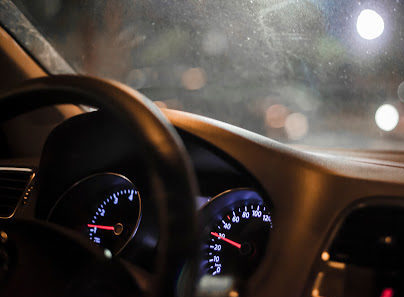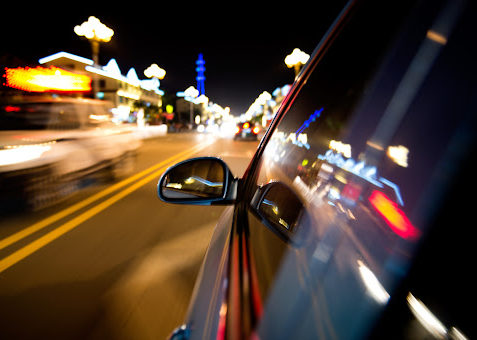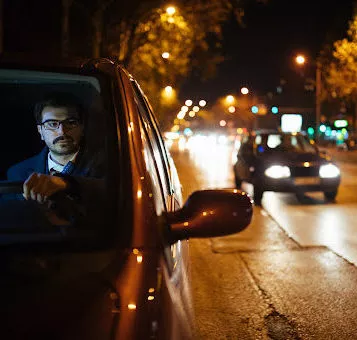6 Safety Tips for Driving at Night

Staying safe while driving is often as simple as following the rules and best practices of the road: stay focused, follow the speed limit, and drive defensively. However, driving at night poses its own challenges, and with the days getting shorter, it’s important to drive safely at all times of day.
Driving at night is more dangerous for a number of reasons, chief among them decreased visibility in the dark and glare from approaching cars and streetlights. With that in mind, Gordon McKernan Injury Attorneys have put together the following tips for driving at night to help you stay safe and help avoid a nighttime car accident.
1. Keep Your Windshield Clean
A dirty windshield is only a minor annoyance during the day, but at night, glare reflecting off the dust and dirt can completely obscure the road ahead. And this isn’t only a problem at night—if the sun hits the dirt on your car’s windshield at the right angle during your commute, you could be driving blind at any time of day.
Make sure to clean your windshield regularly to combat this hazard. Most gas stations have squeegees and water at the pump. Make sure to clean the inside of your windshield with a good glass cleaner, too.
2. Check Your Headlights and Angle Them Correctly
You should check to make sure your headlights and taillights are working properly before every drive, but of course it’s even more vital they work when you’re driving at night. You may even want to turn them on an hour before sunset to help oncoming traffic see you more clearly.
As you’re driving at night, also be sure to angle your headlights properly to avoid distracting other drivers. While your high beams help you see the road ahead, they can greatly lessen other drivers’ visibility—so when you’re approaching an oncoming car or driving behind someone, turn your high beams off.
3. Increase Your Following Distance and Slow Down

The National Highway Traffic Safety Administration (NHTSA) reports that speeding-related crashes make up 37% of nighttime-driving fatalities, compared with only 21% of daytime crashes. A major contributor is your decreased reaction distance: at night, you can only see the reach of your headlights, around 160 feet. But at 40 mph, you’ll need 190 feet to stop.
In addition, be sure not to tailgate at night, even when you’re in a hurry to get home. If the car in front of you is illuminated by your headlights, you’re probably too close to them.
You can also use the 3-second rule to gauge your distance: count the seconds between when the car in front passes some object and when you do. There should be at least 3 seconds between those times; if there isn’t, slow down.
4. Watch for Pedestrians, Animals, and Other Road Users
It can be hard to see bicyclists, pedestrians, animals, horse riders, motorcycles, and other users of the roadway even in the bright daylight. In the darkness of night, they can be even harder to see—and you’ll have less time to swerve to miss them if they run in front of your car.
Walkers, joggers, and others don’t always wear reflective gear, so take extra time to watch out for pedestrians and animals, especially on poorly-lit roadways. Be sure to look out for pedestrians using a crosswalk when stopped at a traffic signal, as well.
5. Take Care of Your Eyesight

You should get your vision checked every year, not only for driving but for the rest of your life as well. However, as people age, glare tends to become a more serious problem when driving at night, and driving at night with astigmatism is especially dangerous. If you find that you’re struggling to see when driving at night, pull over somewhere safe, switch drivers if you can, or wait it out.
When driving at night, you should also avoid looking into approaching drivers’ headlights. The bright glare of their beams could momentarily blind or disorient you, leading to a greater chance of an accident. Instead, shift your gaze down and to the right, keeping track of your position on the road’s surface using the solid white line. When you’ve passed the other car, you can lift your gaze back to the center of the road.
6. Avoid Fatigue
While fatigue, exhaustion, or just plain tiredness can lead to an accident at any time of day, the risk is especially high at night when your natural circadian rhythm makes drowsiness more likely. According to the National Sleep Foundation, over 100 million people have fallen asleep at the wheel.
Losing only two hours of sleep has the same effect on driving as drinking three beers, so it’s vitally important to make sure you get enough sleep, especially if you’re driving at night. If you find yourself beginning to nod off, pull over where it’s safe and take a nap. It’s better to arrive late than not arrive at all.
What to Do If You’re in a Nighttime Accident
Whether you’re in an accident while driving on a two-lane road, a city street, or while driving on the highway at night, you could be facing thousands in property damage and medical bills, as well as years of needless pain and suffering.

If the accident was someone else’s fault, you could be feeling frustration at your situation and wondering where to turn next. The experienced lawyers at Gordon McKernan Injury Attorneys have helped clients recover over $3 Billion in compensation over our 679+ years of combined legal experience, and we can help you too.
Give us a call at 888.501.7888 for a free consultation today. A dedicated personal injury lawyer will listen to your story and offer the help you need to heal.

